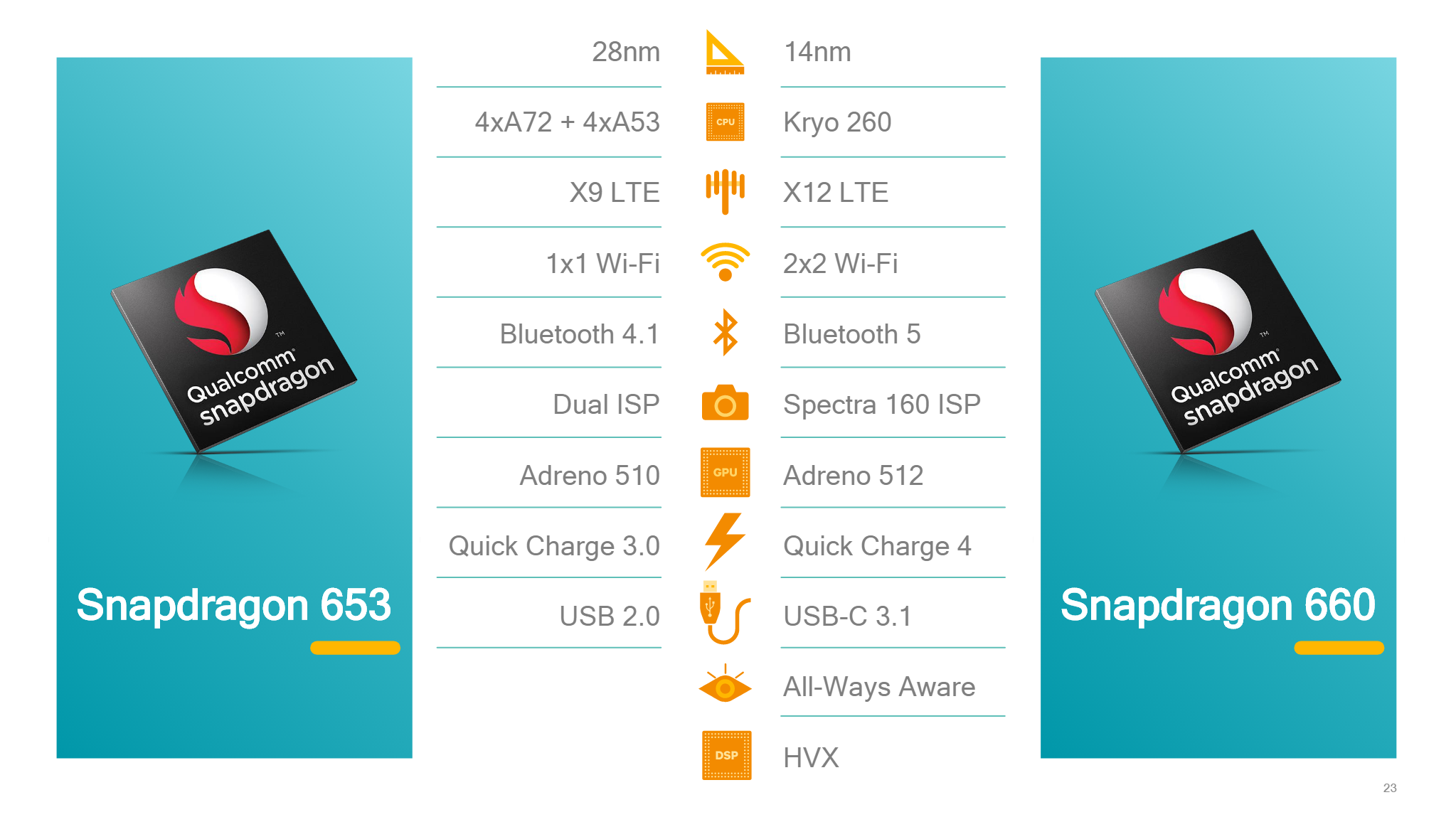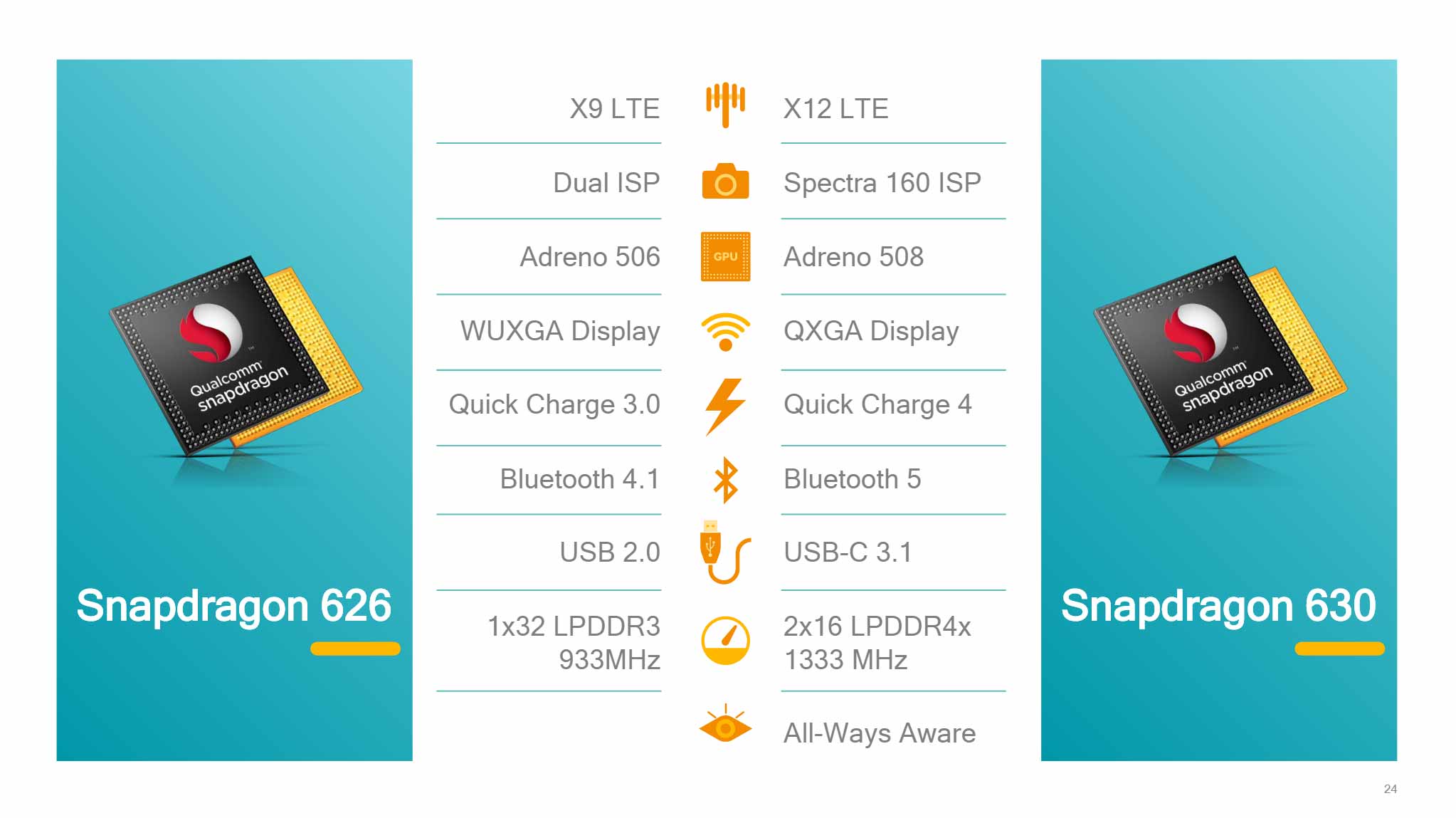
Qualcomm has debuted its next generation of 600-series mobile SoCs, the 660 and 630 — two platforms that will power many of 2017’s mid-range smartphone offerings.
The new platforms, both built on the 14nm FinFET process, promise performance increases enabling better camera and gaming experiences, along with improvements to battery and faster LTE speeds.
According to Qualcomm, the Snapdragon 630 platform is the successor to the Snapdragon 625 — skipping mention of the 626, which didn’t provide many big changes and wasn’t shipped in many popular North American devices. The 625 was included in many popular mid-range devices (some verging on high-end territory) including the Moto Z Play, Asus Zenfone 3 and Huawei Nova Plus. The 660 is the successor to the less-widely used 653.

The company reports improvements in the CPU and GPU performance of both new platforms. The 660 has a 20 percent performance improvement from its predecessor in the Qualcomm Kryo 260 CPU, which has four performance cores clocked at up to 2.2GHz and four efficiency cores clocked at 1.8GHz. It also has a 30 percent performance improvement in the Qualcomm 512 Adreno GPU, which should translate to a better gaming and multimedia experience.
Because of those performance and efficiency improvements, the chipset giant promises “two more hours on the Snapdragon 660 at the end of the day,” in comparison to the 653. The company says this could mean over 10 hours of streaming video or over five days of music playback.
Meanwhile, the Snapdragon 630 boasts a 30 percent increase in GPU performance over its predecessor when it comes to its Adreno 508 graphics processor, and promises a 10 percent increase in CPU performance over the 625, as well. It has four ARM Cortex A53 cores running at 2.2GHz and four running at 1.8GHz.
Both platforms support an 8GB maximum memory and Vulkan API.

On the display front, the Snapdragon 660 Mobile Platform is able to power QHD (quad high definition — 2560 x 1440p) 2K resolutions, while the 630 supports FHD/QXGA (1080p).
The chipsets’ Qualcomm Spectra 160 premium camera ISP (a shared architecture) boasts better power efficiency and higher throughput for dual camera phones and superior low-light photography.
“We’re spending a lot of time trying to provide a DSLR experience in mobile,” said Kedar Kondap, vice-president of product management at Qualcomm in a press briefing.
To that end, the chipset supports bokeh effects, dual-pixel autofocus and optical zoom, which Kondap says consumers can expect to see a lot more in the future from devices on the market.
“We’re spending a lot of time trying to provide a DSLR experience in mobile.”
Additionally, the SoC features the next generation of electronic image stabilization.
“With EIS 3.0, we’re taking it to a different level,” said Kondap, noting that with this version of EIS, multiple frames can be captured in the background before the user presses the capture button, allowing for the best shot to be selected — a technology in use by phones running on Qualcomm’s latest high-end 800 series chips, including the Sony’s Xperia XZ Premium and the Google Pixel.
The 660 and 630 share the same X12 LTE modem, paired with a new SDR660 RF transceiver, which supports peak downlink rates of 600Mbps. The 660 also supports 2×2 MU-MIMO 802.11 ac Wi-Fi, which provides it twice as much data throughput and up to 60 percent lower download consumption as its predecessor, the Snapdragon 652.
Both chips come with RF front-end support including Qualcomm True Signal adaptive antenna tuning with carrier aggregation, which works to automatically optimize signal quality, and will feature Bluetooth 5.
As for availability, Qualcomm notes that the Snapdragon 660 mobile platform is now shipping, and consumers can expect to see devices with the chipset hitting the market by the end of June 2017. The 630 will begin shipping towards the end of May, and is expected to enter the market in devices in the third quarter of this year.
Update 09/05/17: This article originally defined QHD as quarter HD, when in fact it was quad HD. The post has been updated to reflect that.
MobileSyrup may earn a commission from purchases made via our links, which helps fund the journalism we provide free on our website. These links do not influence our editorial content. Support us here.


